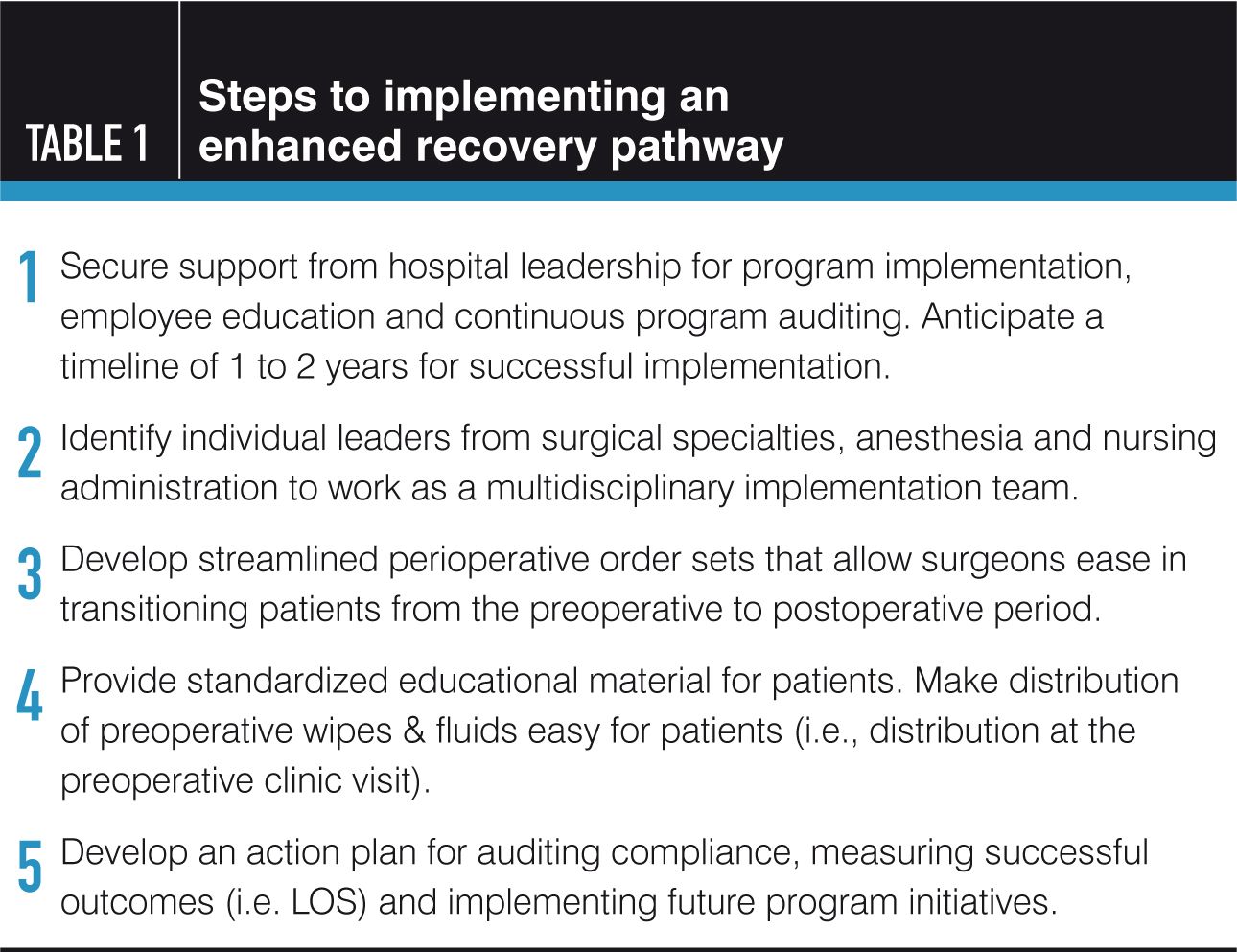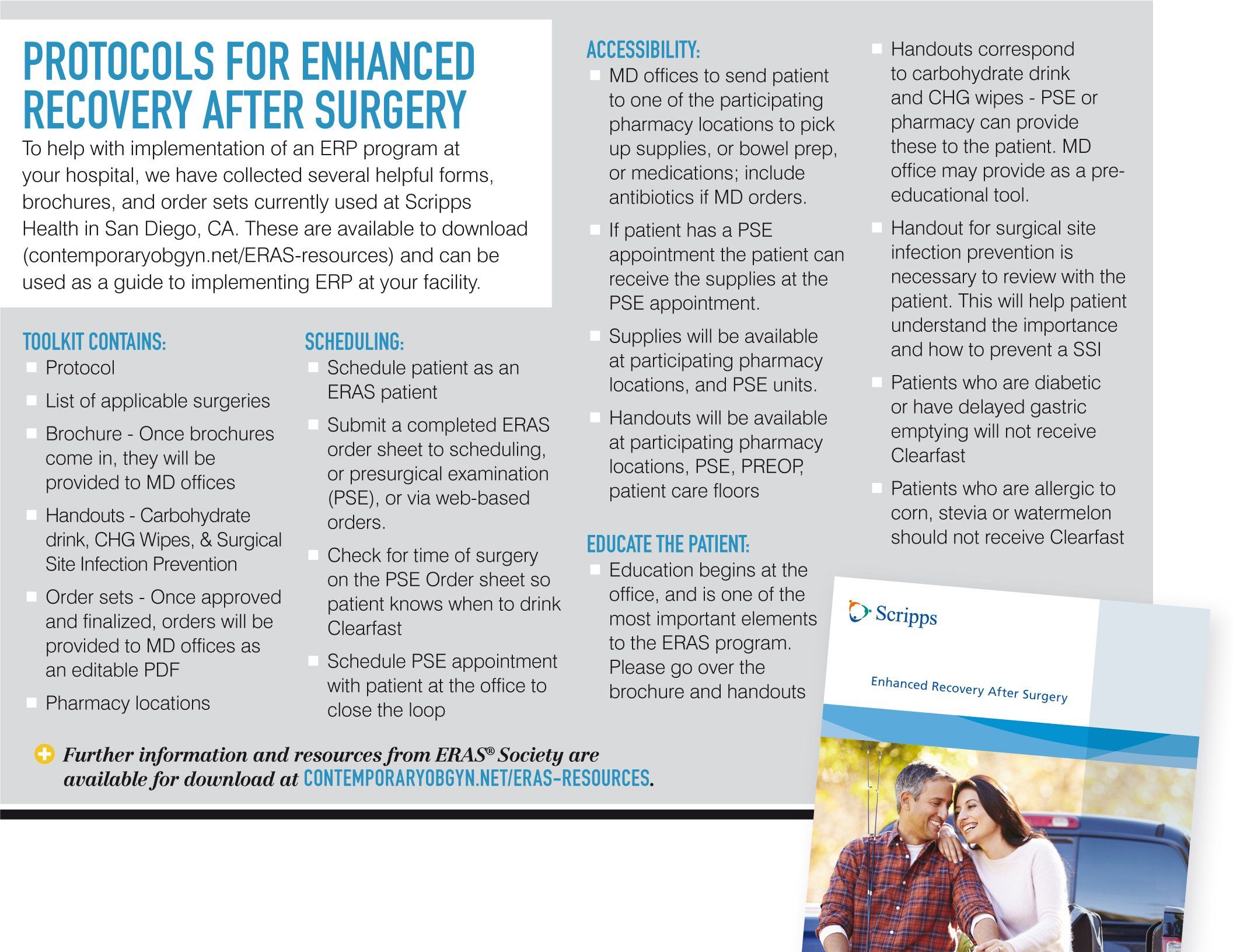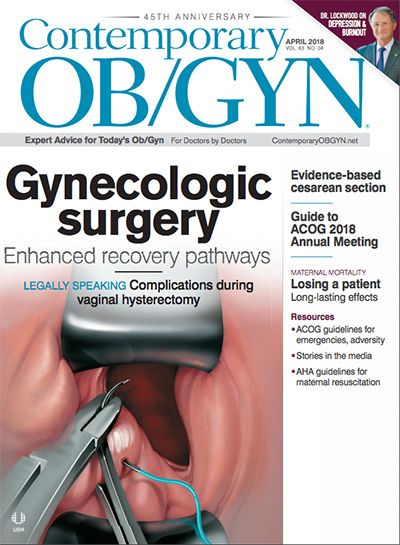Enhanced recovery in gynecologic surgery
ERPs may take a year or two to get gong but the benefits to patients and the healthcare system can be significant.

Enhanced recovery pathways (ERP) are rapidly gaining acceptance and use in gynecologic surgery. Studies have shown that patients on an ERP have fewer complications, a shorter length of hospital stay and attain a higher level of satisfaction with their surgical experience.1-2 ERPs utilize patient-centered multidisciplinary teams to optimize patient outcomes through evidence-based best practices in perioperative care.3 The essentials of ERPs include: 1) reducing surgical stress; 2) maintaining normal physiological function perioperatively; and 3) expediting postoperative recovery.1 While originally based in colorectal surgery, these protocols have been expanded to other surgical specialties, including gynecology. In 2016, the ERAS® Society published guidelines for gynecologic/oncology surgery. Several of these guidelines are well-established standards of care, such as skin preparation, antimicrobial prophylaxis, and thromboembolism prevention. Others, however, represent a significant departure from long-standing practices like the avoidance of prolonged fasting, mechanical bowel preparation, and opioid pain medications. The benefits for patients and health care systems at large argue for prompt implementation of ERP protocols. This article reviews both established and more recent guidelines which have been less readily adopted and describes how to incorporate these guidelines into surgical practice.

Preoperative interventions
Education and counseling. Ideally, preparation for surgical recovery begins at the time surgical management is recommended. Educating patients and caregivers on what to expect before and after surgery leads to decreased fear and anxiety.4 Encouraging patients to actively participate in their recovery facilitates improved compliance and outcomes. Counseling is performed by primary surgeons, perioperative nurses, and anesthesiologists, emphasizing day-to-day goals and expectations during the entire perioperative period. Take-home materials such as enhanced recovery brochures provide resources for patients to reference before and after surgery.
Because opioid abuse has become a public health crisis, it is imperative to adequately and responsibly treat pain secondary to surgery. ERPs focus on non-narcotic multimodal
approaches to pain control during the entire perioperative period, with a goal of reducing opioid consumption. Patients should receive counseling on these pain management strategies and education on opioid risks and ways to minimize opioid use after surgery.
Preoperative optimization. Prior to surgery, nutritional status and medical conditions such as diabetes and anemia should be optimized. Optimization allows the body to prepare for the stress of surgery and reduces surgical morbidity.1 An emphasis should be placed on cessation of tobacco and excessive alcohol use for at least 4 weeks prior to surgery to promote wound healing and reduce postoperative complications.5-9
HRT and OCs. Given that long-term hormone replacement therapy and oral combined hormonal contraceptives are risk factors for postoperative thromboembolism, consideration should be given to discontinuation of them prior to surgery. Alternative forms of contraception or transdermal hormone therapies can be substituted in their place. Employ thromboprophylaxis for patients utilizing these therapies at the time of surgery.
Preoperative bowel preparation. A large body of evidence clearly shows that mechanical bowel prep, especially in gynecology, does not improve surgical outcomes.10 Avoid routine use of mechanical bowel preparation for patients undergoing benign gynecologic procedures.
Preoperative fasting and carbohydrate loading. Preoperative intake of solid food up to 6 hours and clear liquids up to 2 hours prior to surgery is safe.11 Carbohydrate loading with a clear fluid containing complex carbohydrates is known to attenuate insulin resistance, minimize protein and muscle loss, and improve patient comfort.12 At the preoperative visit, patients are instructed to drink 3 12-oz. bottles of Clearfast before their scheduled surgical time, with the last bottle to be consumed 2 hours before anesthesia, as noted in the available schedule. If Clearfast is not available, Gatorade can be used as a substitute.
Preanesthetic medications/nausea prophylaxis. Patients commonly experience high levels of anxiety in anticipation of surgery and may be given anxiolytics preoperatively. However, anxiolytics can cause varying levels of sedation, impairing early oral intake and mobilization.13 Avoid use of long-acting anxiolytics prior to surgery with administration of short-acting agents only as necessary. Instead, consider other strategies to reduce anxiety, including an emphasis on preoperative counseling and education.
While ERAS Society guidelines recommend multimodal opioid-sparing analgesics in the postoperative period, the theory of pain pathway sensitization, or “protective analgesia,” argues for preoperative initiation.14 While there is some controversy regarding the role of oral vs intravenous (IV) analgesics, oral analgesics are certainly safe to use preoperatively. Consider beginning multimodal non-opioid analgesics preoperatively including a long-acting oral nonsteroidal anti-inflammatory drug (NSAID) (celecoxib 400 mg), acetaminophen (1000 mg), and possibly gabapentin (300-600 mg). Then continue the use of multimodal non-opioid analgesics as a mainstay of pain control post-operatively.
Postoperative nausea and vomiting (PONV) can impede the recovery process. A focus on multimodal PONV prophylaxis and prevention throughout the perioperative period should be utilized. Restricted use of inhalational anesthetics combined with 3 or more IV antiemetic medications with different mechanisms of action provide additive effects. The most commonly administered antiemetics are: ondansetron
(4 mg), dexamethasone (4-8 mg), droperidol (0.625 mg) and metoclopramide (10-20 mg). For patients with a history of PONV, consider giving an oral dose of the NK1 receptor antagonist, aparepitant (40 mg) preoperatively.
Intraoperative interventions
Minimally invasive surgery. Minimally invasive approaches to surgery have myriad advantages over laparotomy. Advantages include reduction in intraoperative blood loss, decreased pain and narcotic use, earlier mobilization and return of bowel function, shorter hospital stay and fewer postoperative complications. Minimally invasive approaches to gynecologic surgery, by way of vaginal, traditional laparoscopic or robotic-assisted rooutes, are strongly recommended.15,16
Standard anesthetic protocol. Anesthetic protocols that allow for rapid recovery are strongly encouraged. Use of short-acting agents, such as propofol, promote rapid awakening. In addition, use of regional anesthesia in open abdominal and vaginal cases helps reduce postoperative pain, nausea and vomiting. Unfortunately, its use can also delay mobilization and Foley catheter removal, and should therefore be considered on a case-by-case basis.
Nasogastric intubation. While nasogastric (NG) and orogastric tubes aid in gastric decompression during traditional or robotic-assisted laparoscopy, tubes should be removed prior to patient awakening. In addition, routine placement of NG tubes until return of bowel function is no longer recommended, as systematic reviews have shown improved outcomes in those without traditional NG tube decompression after surgery.17
Preventing intraoperative hypothermia. Hypothermia during the perioperative period can contribute to increased blood loss, a delay in wound healing, increased risk of surgical site infections, and cardiac morbidity.18 Use modalities to prevent intraoperative hypothermia including temperature monitoring, active surface body warming systems, and pre-warmed IV fluids.
Perioperative fluid management. Avoiding mechanical bowel preparation and prolonged preoperative fasting with employment of carbohydrate loading and hydration allows maintenance of a euvolemic state and mitigates the need for excessive fluid resuscitation intraoperatively. ERPs emphasize the concept of euvolemia, or a zero-fluid balance. Excessive IV fluid administration delays patient recovery and increases risk of surgical complications.19-21
Postoperative interventions
Postoperative fluid therapy/nutrition. With early advancement in oral intake, patients require less IV hydration. It can be discontinued once patients are tolerating clear liquids, which in most cases can be safely resumed immediately after surgery.22 For patients who are not discharged same-day, advancement to regular diet can be instituted upon arrival to the floor.
Postoperative analgesia. The use of multimodal opioid-sparing analgesia to adequately treat postoperative pain is a core element of ERPs. Acetaminophen and NSAIDs are the cornerstone of postoperative pain management, and can effectively reduce opioid consumption without compromising pain control or recovery.23 Preoperative administration of these medications, along with dexamethasone, should be given consideration. When used, oral opioid administration is preferred, especially for patients tolerating oral intake.
Peritoneal/urinary drains. Guidelines recommend that routine peritoneal drainage be avoided in gynecologic/oncologic surgery. Urinary catheters should be utilized for a short duration, ideally less than 24 hours after surgery.
Early mobilization. Encouraging patients to mobilize within 24 hours after surgery is strongly recommended to decrease pulmonary complications and length of hospital stay, as well as aid in prevention of thromboembolic events.24
Initiating and maintaining an ERP at your hospital
Steps to consider when implementing an ERP are outlined in Table 1. Securing support for the program from hospital administration, surgical and nursing department heads is critical. Gaining buy-in from a multidisciplinary team of surgeons, anesthesiologists and nursing staff is also essential. Then education and re-education on the pathways for hospital as well as outpatient clinic staff will greatly aid in success. Providing standardized educational materials and establishing easy-to-follow perioperative order sets will make transition to an ERP easier. Finally, true success will be determined by continuous auditing of program compliance and patient outcomes.

Conclusion
As value in healthcare becomes an increasing priority for healthcaresystems, enhanced recovery pathways will play a vital role in improving the quality of care provided to patients. With value measured as a ratio of outcome to cost, ERPs improve outcomes (i.e. quicker recovery, increased patient satisfaction) while reducing costs (i.e. reduced morbidity and length of stay). The use of ERPs is a reason patients should choose your practice for surgical care. With support from hospital leadership, employee education and continuous monitoring of compliance and outcomes, ERPs can be successfully implemented for the care of gynecologic surgery patients in any participating hospital.
Disclosures The authors report no potential conflicts of interest with regard to this article.
REFERENCES
1. Greco M, Capretti G, Beretta L, Gemma M, Pecorelli N, Braga M. Enhanced recovery program in colorectal surgery: a meta-analysis of randomized controlled trials. World J Surg. 2014 Jun;38(6):1531-41.
2. Nicholson A, Lowe MC, Parker J, Lewis SR, Alderson P, Smith AF. Systematic review and meta-analysis of enhanced recovery programmes in surgical patients. Br J Surg. 2014 Feb;101(3):172-88.
3. Ljungqvist O, Scott M, Fearon KC. Enhanced Recovery After Surgery: a review. JAMA Surg. 2017 Mar 1;152(3):292-298.
4. Lawrence D. Egbert, M.D., George E. Battit, M.D., Claude E. Welch, M.D., and Marshall K. Bartlett, M.D. Reduction of postoperative pain by encouragement and instruction of patients - a study of doctor-patient rapport. N Engl J Med. 1964; 270:825-827
5. L.T. Sorenson. Wound healing and infection in surgery: the pathophysiologic impact of smoking, smoking cessation, and nicotine replacement therapy: a systematic review. Ann. Surg. 2012;266(6): 1069 – 1079.
6. Wong J, Lam DP, Abrishami A, Chan MT, Chung F. Short-term preoperative smoking cessation and postoperative complications: a systematic review and meta-analysis. Can J Anaesth. 2012 Mar;59(3):268-79.
7. Oppedal K, Møller AM, Pedersen B, Tønnesen H. Preoperative alcohol cessation prior to elective surgery. Cochrane Database Syst Rev. 2012 Jul 11;(7):CD008343.
8. Tonnesen H, Kehlet H. Preoperative alcoholism and postoperative morbidity. Br J Surg. 1999;86:869–874.
9. Tonnesen H, Rosenberg J, Nielsen HJ, et al. Effect of preoperative abstinence on poor postoperative outcome in alcohol misusers: randomised controlled trial. BMJ. 1999;318:1311–1316
10. Arnold A, Aitchison LP, Abbott J. Preoperative mechanical bowel preparation for abdominal, laparoscopic, and vaginal Surgery: a systematic review. J Minim Invasive Gynecol. 2015 Jul-Aug;22(5):737-52.
11. Brady M, Kinn S, Stuart P. Preoperative fasting for adults to prevent perioperative complications. Cochrane Database Syst Rev. 2003;(4):CD004423.
12. Smith MD1, McCall J, Plank L, Herbison GP, Soop M, Nygren J. Preoperative carbohydrate treatment for enhancing recovery after elective surgery. Cochrane Database Syst Rev. 2014 Aug 14;(8):CD009161.
13. Walker KJ, Smith AF. Premedication for anxiety in adult day surgery. Cochrane Database Syst Rev. 2009 Oct 7;(4):CD002192.
14. Moiniche S, Henrik K, Dahl J. A qualitative and quantitative systematic review of preemptive analgesia for postoperative pain relief: The role of timing of analgesia. Anesthesiology. 2002:96:725-41.
15. Choosing Route of Hysterectomy for Benign Disease. Committee Opinion No. 701. American College of Obstetricians and Gynecologists. Obstet Gynecol. 2017:129:e155–9.
16. Ohtani H, Tamamori Y, Arimoto Y, Nishiguchi Y, Maeda K, Hirakawa K. A meta-analysis of the short- and long-term results of randomized controlled trials that compared laparoscopy-assisted and conventional open surgery for colorectal cancer. J Cancer. 2011;2:425-34.
17. Nelson R, Edwards S, Tse B. Prophylactic nasogastric decompression after abdominal surgery. Cochrane Database Syst Rev. 2007 Jul 18;(3):CD004929.
18. Hart S, Bordes B, Hart J, Corsino D, Harmon D. Unintended perioperative hypothermia. Ochsner J. 2011 Fall;11(3): 259–270.
19. Schol PB, Terink IM, Lancé MD, Scheepers HC Liberal or restrictive fluid management during elective surgery: a systematic review and meta-analysis. J Clin Anesth. 2016 Dec;35:26-39.
20. Corcoran T, Rhodes JE, Clarke S, Myles PS, Ho KM. Perioperative fluid management strategies in major surgery: a stratified meta-analysis. Anesth Analg. 2012 Mar;114(3):640-51.
21. Miller TE, Raghunathan K, Gan TJ. State-of-the-art fluid management in the operating room. Best Pract Res Clin Anaesthesiol. 2014 Sep;28(3):261-73.
22. Charoenkwan K, Matovinovic E. Early versus delayed oral fluids and food for reducing complications after major abdominal gynaecologic surgery. Cochrane Database Syst Rev. 2014 Dec 12;(12):CD004508.
23. Wong M, Morris S, Wang K, Simpson K. Managing Postoperative pain after minimally invasive gynecologic surgery in the era of the opioid epidemic. JMIG. 2017 Sept
24. Nelson G, Altman A, Meyer LA, et al. Guidelines for postoperative care in gynecologic/oncology surgery: Enhanced Recovery After Surgery (ERAS) Society recommendations – Part II. Gynecologic Oncol. 140. 2016 323-332.


